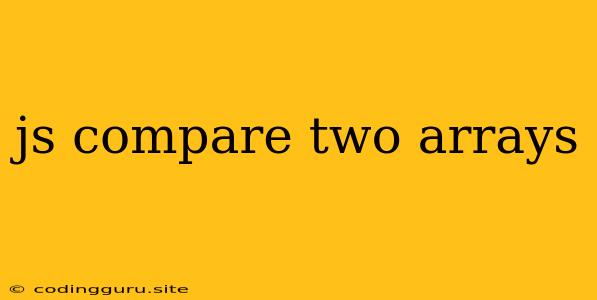How to Compare Two Arrays in JavaScript: A Comprehensive Guide
Comparing two arrays in JavaScript is a common task, especially when working with data manipulation and analysis. There are various methods to achieve this, each with its own advantages and use cases. This guide will provide a comprehensive overview of different techniques for comparing JavaScript arrays.
Understanding Array Comparison in JavaScript
Before diving into the methods, it's important to clarify what "comparing" arrays in JavaScript entails. You can compare arrays in two main ways:
- Equality: Determining whether two arrays have the same elements in the same order. This is typically used when you need to check if two arrays represent the same data structure.
- Content: Checking if two arrays have the same elements, regardless of their order. This is useful when you're focusing on the content rather than the exact arrangement of elements.
Methods for Comparing Arrays
Let's explore some common methods to compare arrays:
1. Strict Equality (===):
The === operator checks for strict equality, meaning it considers both the value and the data type. While this works for primitive values, it's not suitable for comparing arrays directly, as they are reference types. Two arrays, even with the same elements, will not be strictly equal because they reside in different memory locations.
const array1 = [1, 2, 3];
const array2 = [1, 2, 3];
console.log(array1 === array2); // Outputs: false
2. The every() Method:
This method is useful for checking if all elements in one array satisfy a condition. You can combine every() with a callback function to check if each element in one array exists in the other.
function arraysEqual(arr1, arr2) {
if (arr1.length !== arr2.length) return false;
return arr1.every((element, index) => element === arr2[index]);
}
const array1 = [1, 2, 3];
const array2 = [1, 2, 3];
console.log(arraysEqual(array1, array2)); // Outputs: true
Important: This method ensures equality in both value and order of elements.
3. The some() Method:
some() is similar to every() but checks if at least one element in the array meets a condition. This method is useful for determining if any element in one array is also present in another.
function hasCommonElements(arr1, arr2) {
return arr1.some(element => arr2.includes(element));
}
const array1 = [1, 2, 3];
const array2 = [3, 4, 5];
console.log(hasCommonElements(array1, array2)); // Outputs: true
4. The forEach() Loop with includes():
You can iterate through one array using forEach() and check if each element is present in the other array using the includes() method.
function arraysEqual(arr1, arr2) {
if (arr1.length !== arr2.length) return false;
arr1.forEach((element, index) => {
if (!arr2.includes(element)) {
return false;
}
});
return true;
}
const array1 = [1, 2, 3];
const array2 = [1, 2, 3];
console.log(arraysEqual(array1, array2)); // Outputs: true
5. Comparing Sorted Arrays:
If the order of elements doesn't matter, you can sort both arrays and compare them directly using strict equality.
function compareSortedArrays(arr1, arr2) {
if (arr1.length !== arr2.length) return false;
return arr1.sort().toString() === arr2.sort().toString();
}
const array1 = [3, 1, 2];
const array2 = [2, 1, 3];
console.log(compareSortedArrays(array1, array2)); // Outputs: true
Tips for Efficient Array Comparison:
- Choose the right method: The best approach depends on the specific comparison goal.
- Avoid unnecessary loops: Consider using built-in methods like
every()orsome()when possible. - Optimize for performance: For large arrays, sorting and comparing can be computationally expensive.
Examples:
-
Checking for equal elements in the same order:
const array1 = [1, 2, 3]; const array2 = [1, 2, 3]; const areEqual = array1.every((element, index) => element === array2[index]); console.log(areEqual); // Outputs: true -
Checking if any element is present in both arrays:
const array1 = [1, 2, 3]; const array2 = [3, 4, 5]; const hasCommonElements = array1.some(element => array2.includes(element)); console.log(hasCommonElements); // Outputs: true
Conclusion:
Comparing arrays in JavaScript can be done in various ways, each offering unique advantages and efficiencies. The every() and some() methods provide concise solutions for comparing arrays based on specific conditions. Always consider the nature of the comparison and choose the appropriate technique to ensure accurate and efficient code.
